Shopify Tiered Pricing: The Top Types & Apps for 2025
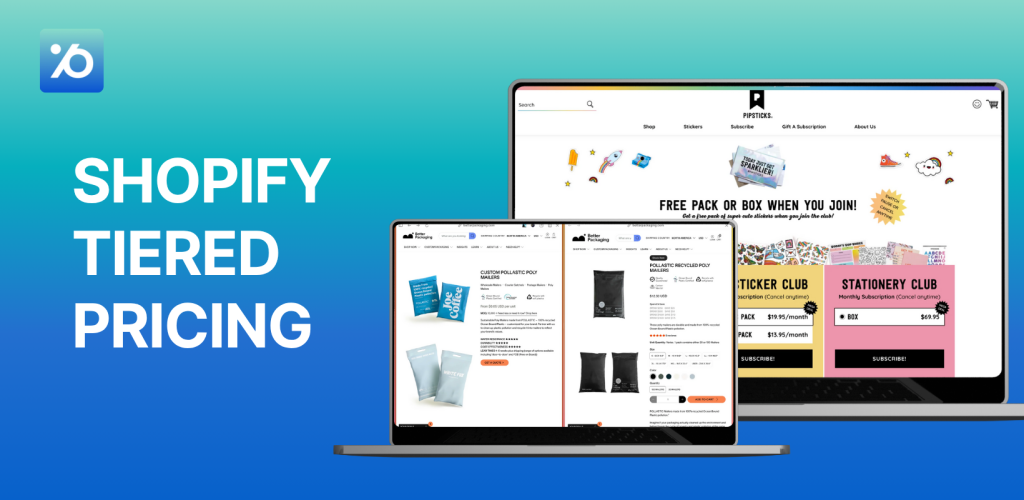
Running a Shopify store means you’re always looking for ways to get customers to buy more. What if there were a simple trick that could make shoppers add extra items to their cart without feeling pushed? That’s exactly what Shopify tiered pricing does.
Think about it – when you see “Buy 2, get 10% off; Buy 5, get 20% off,” doesn’t it make you consider grabbing a few more items? That’s the magic of Shopify tiered discounts in action.Let’s figure out which type and app suit you best!
What Is Tiered Pricing?
Tiered pricing is a strategy where you offer progressive discounts based on purchase quantity. The more customers buy, the bigger the discount they receive.
This pricing model influences buying behavior in two ways. First, customers perceive they’re getting better value at higher quantities, which encourages larger orders. Second, seeing the potential savings side-by-side with different tier options triggers loss aversion – customers don’t want to miss out on the better deal.
The result: customers save money on bulk purchases, and you increase your average order value.
What Is Shopify Tiered Discounts?
Shopify tiered discounts work similarly but use the discount system instead. Rather than changing the actual price, you apply discounts when customers hit certain thresholds. Here’s how it works with coffee beans: You set discount rules like:
Here’s how it works with coffee beans: You set discount rules like:
- First 50 bags: $1.00 each
- Next 50 bags(51-100): $0.90 each
- Beyond 100 bags: $0.80 each
So, if a customer orders 120 bags, here’s how the cost breaks down:
- 50 bags × $1.00 = $50
- 50 bags × $0.90 = $45
- 20 bags × $0.80 = $16
Total: $111
What’s the difference? Tiered pricing usually shows different prices upfront (like wholesale pricing), while tiered discounts apply at checkout. Both get the same result – customers pay less per item when they buy more.
Types of Shopify Tiered Pricing That Actually Work
Not all tiered pricing is the same. Different approaches work better for different businesses. Here are the main types you should know about:
Feature-Based Tiers
Feature tiers organize your products into good-better-best versions, where each level unlocks additional capabilities or quality. Customers pick the version that matches their needs and budget.
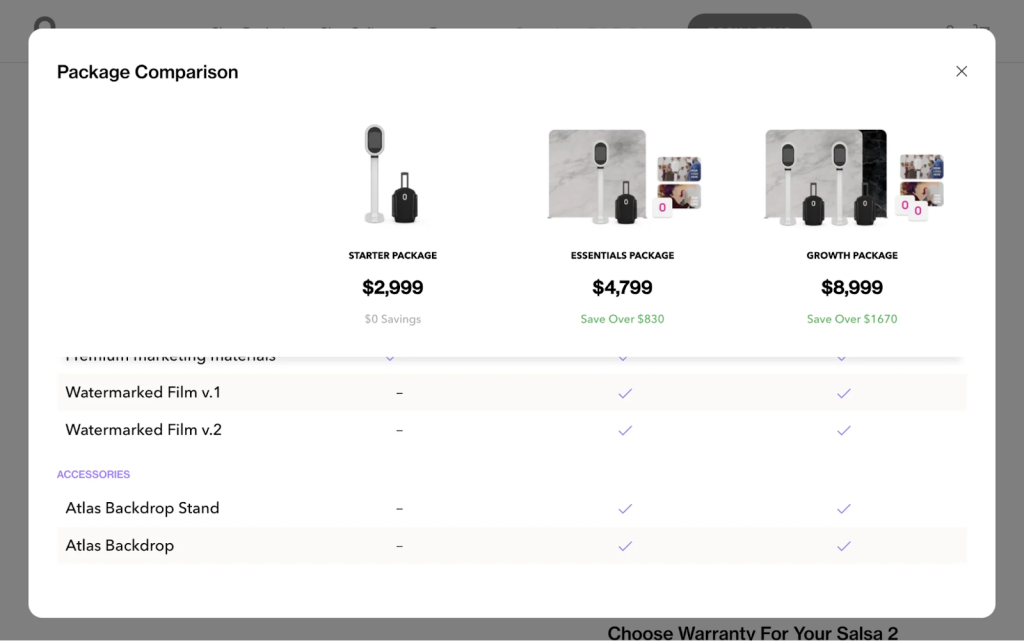
How it works: Basic version with core features, Premium adds extras, Deluxe includes everything. Each tier is a distinct product offering with clear value differences.
Why it works so well: It removes the “one size fits all” problem. Budget-conscious customers get an entry point, while others can upgrade for features they actually want. People also associate higher prices with better quality, making premium tiers naturally appealing.
Perfect for: Products where you can clearly show what extra value each tier provides. Photo booth companies offering starter vs. professional packages, furniture lines with standard vs. luxury finishes, or service businesses with basic vs. comprehensive plans.
Subscription Tiers
Subscription tiers let customers choose their commitment level for recurring deliveries or access. Higher tiers typically include more products, better perks, or exclusive benefits.
How it works: Customers select from options like Starter ($15/month), Standard ($30/month), or Premium ($50/month), each delivering different quantities or features on a set schedule.
Why it works so well: It creates predictable income for you while giving customers flexibility. The recurring nature builds habits – customers stick with subscriptions far longer than one-time purchases. Plus, tiered options let people start small and upgrade as they see value.
Perfect for: Products customers need regularly – coffee, skincare, pet supplies, meal kits. Also works great for membership access, software tools, or any service people use consistently over time.
Usage-Based Tiers
Usage-based pricing charges customers based on how much they actually consume. You only pay for what you use, whether that’s products ordered or services utilized.
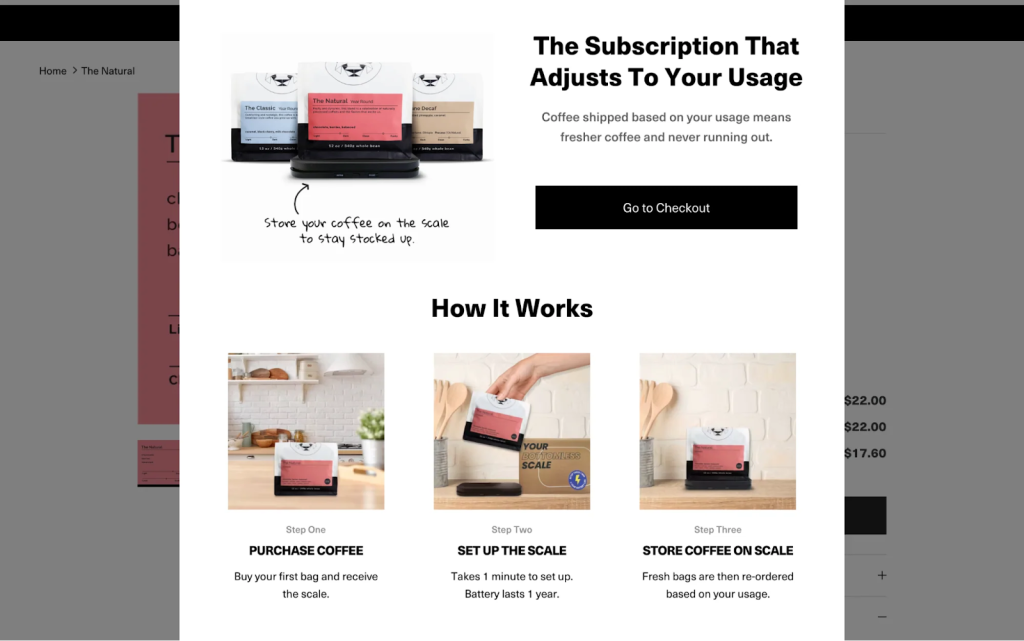
How it works: Smart systems track consumption and bill accordingly. A coffee subscription might monitor how quickly you drink coffee and ship more when you’re running low. Cloud storage charges per gigabyte used.
Why it works so well: Customers feel they’re getting a fair deal because costs match their actual needs. No one pays for waste, and heavy users don’t feel ripped off. It also encourages natural growth – as customers find more value, they consume more.
Perfect for: Products with highly variable consumption rates between customers. Coffee subscriptions, cloud services billed by storage, printing services charged by page count, or any situation where usage tracking makes sense.
Dynamic Tiered Pricing
Dynamic tiers combine structured pricing levels with real-time adjustments based on demand, inventory, seasons, or customer behavior. Your tier structure stays, but the actual prices flex with market conditions.
How it works: You maintain discount tiers (like 10% off for 5 units), but the base price adjusts when demand spikes or inventory runs low. Apps track metrics and modify prices automatically within your rules.
Why it works so well: You maximize revenue during high-demand periods without losing the incentive structure that drives bulk purchases. During slow seasons, you can drop prices to move inventory while still rewarding larger orders.
Perfect for: Businesses with seasonal swings, fluctuating costs, or time-sensitive inventory. Fashion retailers with end-of-season needs, food products approaching expiration, or any situation where market conditions change frequently.
How To Set Up Shopify Tiered Pricing?
Ready to implement tiered pricing? You have two main options to get started, each with its own benefits and limitations. Let’s break down each approach:
Option 1: Use Shopify’s Built-in Discounts (Free Method)
This approach uses Shopify’s native discount system and costs nothing to implement, though it comes with some restrictions.

How it works:
- Create separate discount codes for each tier (like SAVE10, SAVE20)
- Set minimum quantity or spending requirements for each code
- Customers manually enter codes at checkout to get their discount
Best for: Simple setups with basic tiered offers.
Limitations: Customers must remember and enter codes manually, and you can only create basic tier structures.
Option 2: Use a Tiered Pricing App (Recommended)
There are many apps on the Shopify App Store, like Pareto: Volume Discount & Bundles can help you create true tiered pricing that automatically applies as customers add items to their cart.
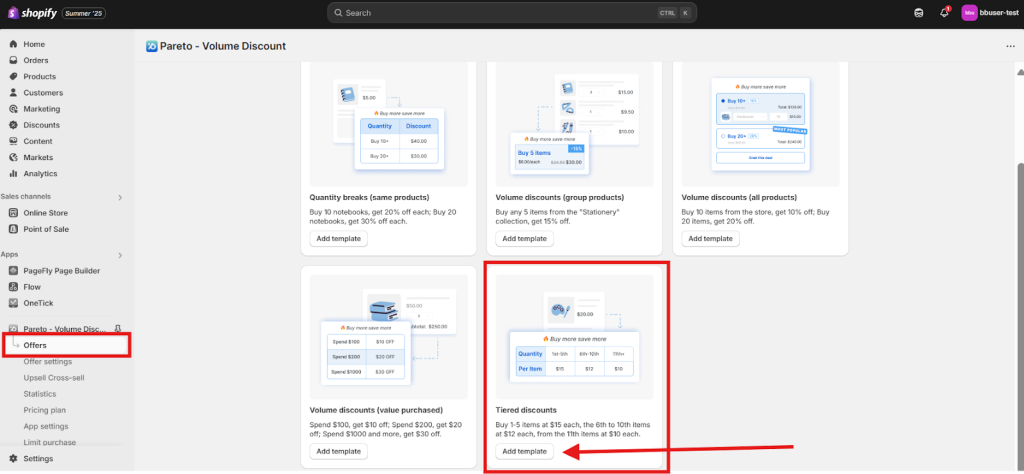
How it works:
- Set up visual pricing tables that show on product pages
- Discounts apply automatically when quantity thresholds are met
- Customers see exactly how much they’ll save before adding to cart
Best for: Professional stores wanting seamless, automatic tiered pricing with visual displays
Benefits: No codes needed, better customer experience, and more advanced tier options.
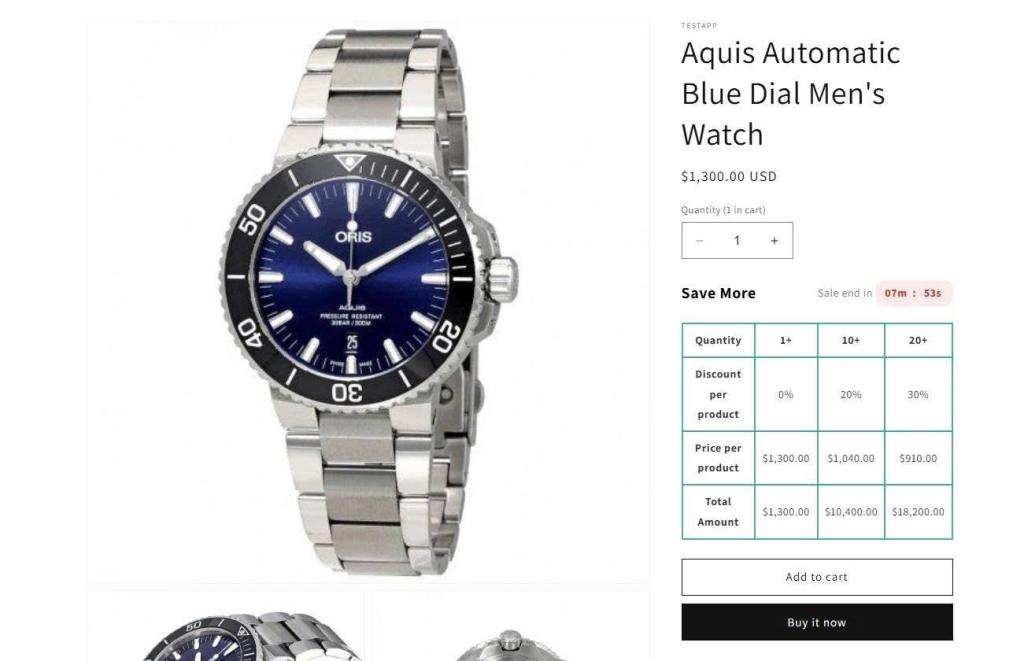
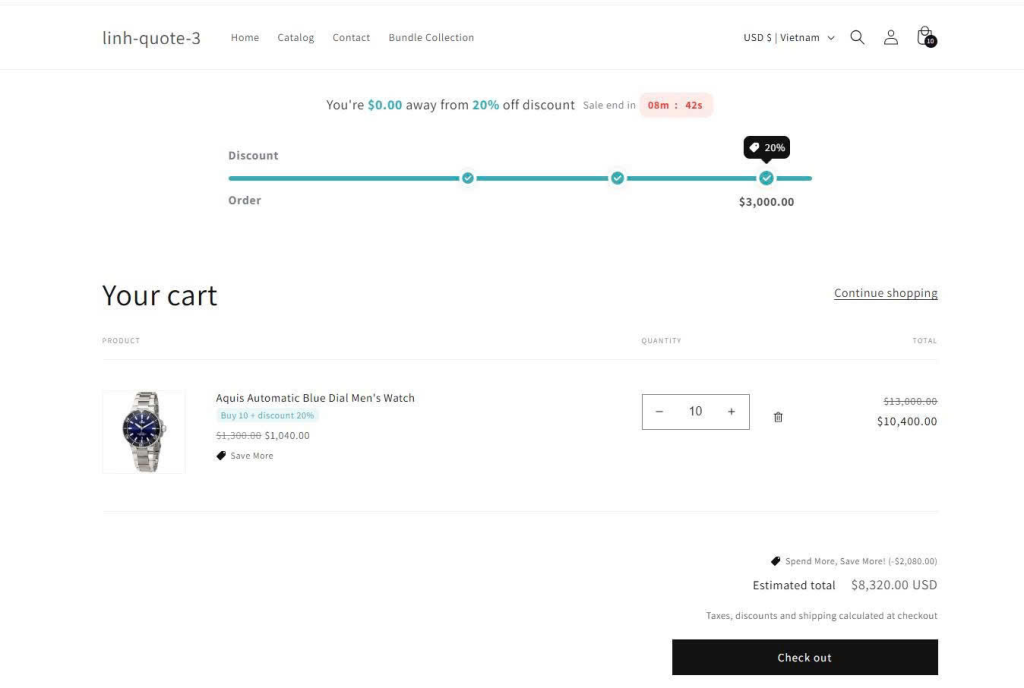
Both methods require strategic planning to set effective tier thresholds and pricing structures. For complete step-by-step instructions on implementing either approach, including specific examples and best practices, check out our detailed guide here, where we walk you through the entire setup process.
Tips to Implement Shopify Tiered Pricing
Shopify tiered pricing works through apps or built-in discount tools. Here are practical tips to get the best results.
Design Your Tier Structure Smart
- Stick to 3-4 tiers maximum. More options confuse customers and kill conversions. Each tier needs a clear purpose – starter level, most popular choice, and bulk option.
- Use real purchase data, not guesses. Check your order history to see where customers naturally buy. If most people order 5-10 units, don’t set your first discount at 50 units. Meet customers where they already shop.
- Calculate profit for every tier before launch. Include all costs – product, shipping, fees, fulfillment. Growing volume at a loss doesn’t help your business. Make sure every tier stays profitable even at the highest discount.
Segment Your Customers
- Create different tiers for different buyers. Wholesale customers need different pricing than retail shoppers. Use customer tags or separate storefronts to show the right pricing to each group.
- Hide retail prices from wholesale accounts. B2B buyers expect custom pricing. Apps can show only wholesale tiers to logged-in business customers.
- Match tier names to your audience. Corporate buyers respond to “Business” or “Enterprise.” Regular shoppers prefer “Starter” or “Best Value.”
Get the Technical Setup Right
- Use apps instead of native discounts. Shopify’s built-in discounts only apply one per order. Apps like Bold Custom Pricing handle multiple progressive tiers automatically.
- Test on all devices before launch. Most Shopify traffic comes from phones. Make sure your pricing displays correctly on mobile, tablet, and desktop.
- Run test orders at key points. Order exactly at tier thresholds, just below them, and above them. Test with different customer accounts to verify everything works.
Show Pricing Clearly
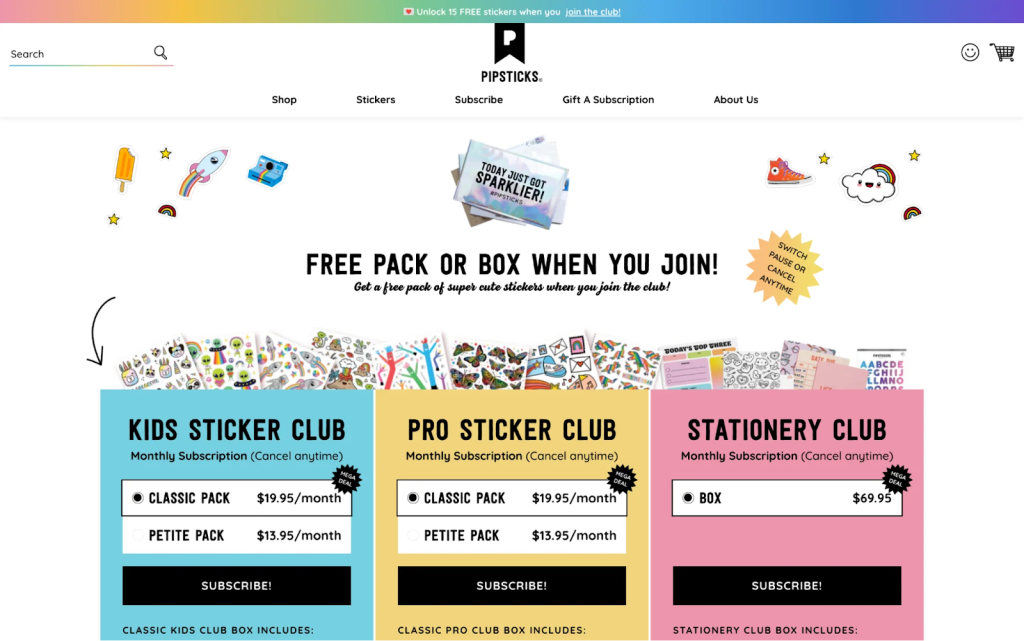
- Make tiers visible with comparison tables. Customers should instantly see all options, discounts, and savings. Use bold text, contrasting colors, and clear messages like “Save 15% when you buy 10+.”
- Show dollar amounts, not just percentages. “Save $50” beats “Save 10%” every time. Display both per-unit savings and total order savings.
- Keep messaging consistent everywhere. Show tiered pricing on product pages, cart notifications, and email confirmations. Customers shouldn’t have to hunt for pricing information.
- Nudge customers to higher tiers. When someone is close to the next level, tell them. “Add 2 more items to save $25” can push people to buy more.
Monitor and Improve
- Watch which tiers customers choose. If everyone picks the same tier, adjust your structure. You want customers spread across multiple tiers.
- Check cart abandonment at tier breaks. If people abandon just below a threshold, lower that minimum slightly. Small changes can boost conversions significantly.
- Review margins monthly. Costs change. What was profitable six months ago might not be today. Regular reviews keep every tier sustainable.
Avoid These Mistakes
- Don’t set thresholds too high. If typical orders are 5 units, starting discounts at 20 units won’t work. Start where customers already buy, then encourage them to increase gradually.
- Make tier differences meaningful. A 2% discount between tiers won’t change behavior. Aim for at least 5-10% jumps to motivate larger orders.
- Keep it simple. Tiers that only work on certain products or certain days confuse people. Simple, always-available tiers perform better.
Bonus Tips from Pareto Apps
To maximize your profit throughout the year, don’t rely on just one type of promotion. The most successful brands mix and match different discount strategies for each campaign, season, or customer segment – leveraging the power of flexibility.
We suggest that 80% of your results come from 20% of your efforts. In retail, this means:
- 80% of revenue often comes from 20% of your products
- 80% of profits come from 20% of your customers
- 80% of sales come from 20% of your promotions
The key insight: Focus your energy on the strategies that deliver the biggest impact, and stay flexible enough to adapt quickly.
Here are some popular discount strategies you should combine:
- Volume Discounts: Offer reduced pricing when customers buy in larger quantities.
- Best for: B2B sales, wholesale, consumable products, or items with high inventory
- Buy X Get Y (BOGO): Reward customers who purchase a specific quantity with free or discounted items.
- Best for: Product launches, seasonal campaigns, or building trial among new customers
- Bundles & Combos: Package multiple products together at a special discounted price.
- Best for: Cross-selling, clearing old inventory, creating gift packages, or increasing basket size
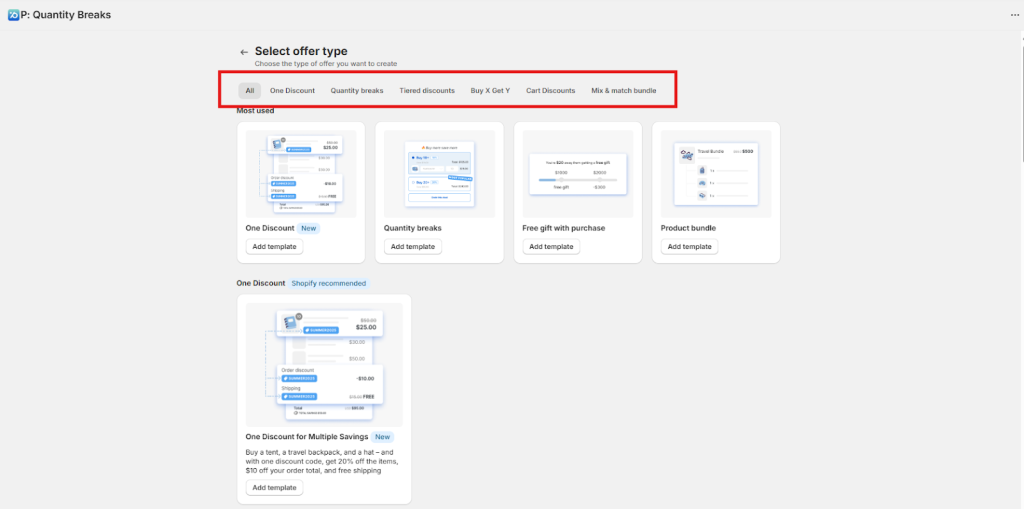
The main point? You don’t need multiple apps or complex manual setup. Pareto: Volume Discount & Bundles gives you the power to:
✅ Create volume discounts with tiered pricing in seconds
✅ Set up BOGO offers (Buy 2 Get 1, Buy 3 Get 50% off, etc.)
✅ Build product bundles and combos with custom pricing
✅ Mix and match strategies for different campaigns
✅ Target specific products, collections, or customer segments
✅ Automate everything—no manual calculations needed
Plus, you can go beyond the basics:
- Quantity breaks with unlimited tiers
- Conditional discounts based on cart value or customer tags
- Flexible rules for complex promotions
- Real-time preview so customers see savings instantly
Don’t just pick one, combine and rotate discount types based on your goals:
- For new product launches:
- Use BOGO to drive trial (“Buy our new flavor, get a classic free”)
- Add bundles to introduce the product alongside bestsellers
- For seasonal sales:
- Start with volume discounts to reward early bulk buyers
- Layer in bundles for gift-giving occasions
- Finish with BOGO to clear remaining inventory
- For targeted customer segments:
- Offer volume discounts to your top 20% of customers
- Use BOGO for customers who haven’t purchased in 60+ days
- Create exclusive bundles for email subscribers or VIP members
- For special events (Black Friday, holidays):
- Stack promotions: “Buy 3+ items, get volume pricing + free gift”
- Create urgency: “Bundle deal ends in 24 hours”
- Test different offers on different days
Smart discounting isn’t about slashing prices everywhere – it’s about strategic flexibility. Experiment with different tactics, measure what works, and concentrate your efforts on the strategies that deliver the biggest returns. With Pareto, you can stay agile and turn discounting into a competitive advantage.
Wrapping Up
Shopify tiered pricing isn’t just a nice-to-have feature – it’s a proven strategy for growing your business. Whether you’re trying to increase order values, reduce cart abandonment, or reward loyal customers, the right tier structure can make a real difference. The question isn’t whether tiered pricing will work for your store – it’s which type and app will work best. Why not start with P: Volume Discount & Bundles? You can try it completely free before spending a dime. With powerful features and a 24/7 support team ready to help, we’re confident we can help boost your revenue!
